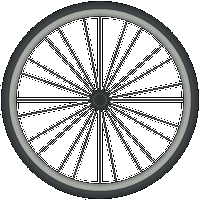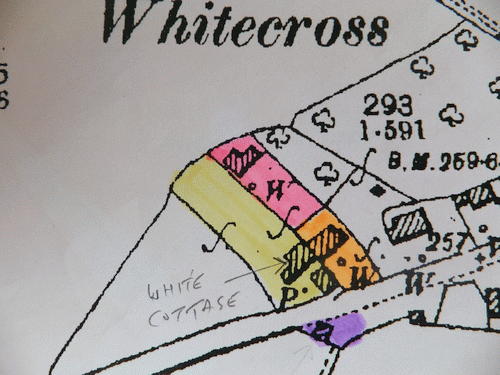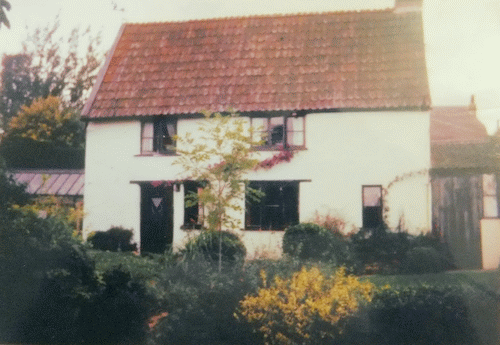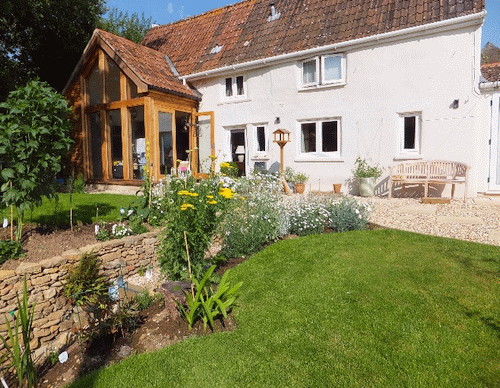For the White Cottage’s history, I have drawn heavily on Linda Le Breton’s excellent research, “The Tizard Family Plot at Whitecross in Netherbury” and her “Timeline for the Tizzard family plot at Whitecross”.
On 17th January 1763, a Richard Tyzard of Netherbury married Mary Randle in Beaminster and over the next 18 years they had eight children, 4 boys, 4 girls. This suggests, although there is no documentary proof, that The White Cottage existed from at least the mid-eighteenth century.
Richard’s parcel of land appears to have been the area now occupied by The White Cottage and that of High Cross Cottage behind.
Their eldest son Richard died aged 35 in April 1799. This may have prompted Richard Snr to make a Surrender the following year 1800 for at least one of his remaining three sons, Joseph baptised June 1772. He divided his land into strips. Joseph’s “middle or central part” included High Cross Cottage [1427 in the later Tithe Map below]. At the time of the Surrender dated 10th January 1800 this section carried “Four Cottages or Dwellings and a Fuelhouse” referred to as “lately erected”. Joseph was ‘admitted’ to his section on 28th May 1804. From Linda’s “Timeline”, Joseph’s descendants appear to connect with High Cross Cottage.
At some point the western section was surrendered to John, the eldest surviving son. John’s western strip [1430] stretched down as far as what is now a tiny triangle of land [1429] on the other side of the lane, directly opposite The White Cottage.
There does not seem to be any mention of how the third surviving son James baptised September 1775 fared. It is reasonable to assume an eastern section went to James, though any records of this have yet to come to light.
At that time, daughters generally did not count. So Ann, baptized June 1776, Mary, September 1768, another Mary, June 1778 [did the first Mary die before her tenth year?] and Elizabeth, August 1781, do not appear in property records.
John’s western strip is mentioned in a 1930’s Abstract of Title as being originally Richard Tizard’s and then his son John’s. It mentions a “dwellinghouse and buildings lately erected thereon by … John or then standing thereon.” The dwellinghouse was what is now The White Cottage. The Abstract goes on: “And secondly All that sometime since newly erected cottage or dwellinghouse site on south side of garden then late of said John Tizard …”. This is the little triangle marked 1429, mentioned below.
It might be that the combined death of his eldest son Richard in April 1799 and the marriage of his second son John in September of that year were two factors influencing Richard Senior’s Surrender in January 1800. John Tizard and Priscilla Mason married at Netherbury in September 1799 and baptised their first son William in January 1801. They went on to have seven children in all, of whom one, Ann, died soon after birth.
When he was twenty-one, William married Eleanor Maber at Netherbury in June 1822. Whether the two wanted to marry or not, it must have become necessary, as their first child Jane appeared six months later in December 1822. Five months after that in May 1823 John surrendered to William a southern section of his strip and William was ‘admitted’ to it on the same date. Was John banishing his wayward son from his house, or did John understand that “In the Spring a young man’s fancy lightly turns to thoughts of love” and William and Eleanor needed their own space? Whatever John felt, he acted fast on learning of Eleanor’s pregnancy – she was only two months gone when he made the piece of land over to William.
Nine further children appeared over the years. Quite how you brought up that many on a tiny triangle of land is matter for conjecture. Maybe the children lived largely out of doors; maybe some of them were brought up by their aunts on John’s western strip. John’s daughters Ann and Fanny [Frances], sisters to William, appear on the 1841 census at home with their father John. It was not uncommon at that time for children to be farmed out to other family members – one of Jane Austen’s several brothers was brought up in the late 18th century by distant cousins.
What we do know is that in 1835, by which time William and Eleanor had seven children, the Tithe Map records the little house on William’s triangle [though it does not mention any garden] and his name against it in the Tithe Register, Entry 1429. It also indicates the road as we know it now, dividing it from the rest of John Tizard’s western plot. John’s plot is described as “House and Garden”, Entry 1430.
In March 1843, close to his 73rd birthday, John surrendered the rest of his plot to William. By then William and Eleanor had produced nine of their ten children, all but one of whom, 13-year-old Priscilla, show on the 1841 census – where was she? Was she farmed out to another branch of the Tizards – they were an extensive family in this area at that time? Had she been sent away to work? Her two elder sisters are at home – perhaps they were helping Aunts Ann and Fanny to bring up Mary, John, Thomas, Ann, Harriet and Ellen, and look after Grandpa John [71] and Grandma Priscilla [67]?
At the next census in 1851, 23-year old Priscilla is back home, but Jane, Elizabeth, Mary, Ann and Ellen are gone and grandfather John Maber [80], Eleanor’s father, has come to live with them.
When he died in his mid-eighties in August 1854, John left his strip to William.
William also lived to a good age, dying at the age of 83 in October 1884, and left his strip, presumably including the triangle, to his married third daughter Mary Vincent. Were the elder girls Jane and Elizabeth not married and is that why they were not left a share in the plot?
Mary sold the property on to Robert Symes of Netherbury for £55. She still shows on the next census in 1891 directly after Robert Symes, as a widow living on her own means, but by 1901 she is no longer there, Robert Symes has married Annie from Yeovil, and they are bringing up nephew George Legg aged 14. Robert’s Will leaves, “my field … and my tiled cottage” to George Legg. George actually got High Cross Cottage which these days is thatched. Robert’s “orchard and my other two houses” went to another nephew Thomas Symes of Evershot. On the 1835 tithe map there are two orchard plots directly across the road by the triangle, a small semi-circle 1356 and a large square plot 1354. On her timeline, Linda calls the triangle the Southern Plot.
Amongst the White Cottage papers is an extract from a 1903 Ordnance Survey map (above). High Cross Cottage is shown in the pink highlighted section, The White Cottage in the yellow section and another cottage in the orange, along with a small building where The White Cottage’s garden steps are today. Neither of the last two buildings now exist, nor the well, marked ‘W’, which was where the hard standing now is. William’s little triangle cottage is still shown over the road, highlighted in purple. Nephews George Legg and Thomas Symes inherited on the death of widow Annie Symes in 1925.
By 1930, west and central strips are in the ownership of Archibald Sutcliffe Knight, an estate agent. Linda Le Breton says the little triangle house seems to have gone by then. Knight separates the land into two. High Cross Cottage gets the northern section, and The White Cottage the southern.
A Miss Dyer-Hughes buys The White Cottage for £140 that year and makes a £20 profit selling it straight on to a Mrs Goodenough. She and her husband live there, he getting a life interest in it after her death in 1956, and himself dying in 1967. Mrs Goodenough’s daughter Joan Melling inherits, sells a strip of the land for High Cross Cottage to have a driveway, and sells the remainder to Mrs Dora Hartley in 1970 for £4,300. In 1995 Alan Lewis buys it for £76,500 [inflation and property prices went through the roof in the seventies and eighties]. Two years later he sells on to Linda Le Breton and Keith Atkinson. Linda sold The White Cottage in 2012 to Richard and Mary Payne from Tunbridge Wells, who wanted a place in the country for occasional breaks, or perhaps to explore the area for eventual retirement. They apparently moved to Devon, selling in 2016 to Diana Maxwell, the current owner.
In September 2004, a lady called Caroline Scott, daughter of Mrs Dora Hartley, sent an old photograph she had discovered of the cottage when her parents bought it in 1970 – she talks of “enjoying many a holiday there”. The core of the house remains outwardly virtually the same. By 2019, the single storey extension on the right now has French doors, and on the left is a kitchen diner with a bedroom above. What looks like a greenhouse or potting shed behind in the 1970 photo no longer exists.





